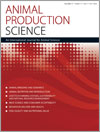
Animal Production Science
Volume 51 Number 11 2011
AN10044 The challenge and limitations of combining data: a case study examining the relationship between intramuscular fat content and flavour intensity based on the BIF-BEEF database
Data related to muscle biology from experiments carried out over a 10-year period were gathered together to better predict beef quality. Intramuscular fat level and flavour were slightly associated in the case of young bulls except for very low values or higher values of intramuscular fat for steers or females. Thanks to a better standardisation across data, this type of research helps to address relationships between muscle characteristics and beef quality by meta-analysis.
AN11010 Pasture systems to improve productivity of sheep in south-western Victoria 2. Animal production from ewes and lambs
Many pastures in southern Australia are dominated by volunteer annual species but below optimum soil fertility greatly reduces pasture productivity. Our research at five on-farm locations in southern Victoria showed that overcoming nutrient deficiencies and improving pasture composition and growth doubled the carrying capacity of the paddocks as well as increasing production per head. Upgrading pastures is profitable providing a 27% return on investment to the producer and could double output of meat and wool in the region.
AN11041 Is polyethylene glycol innocuous to the rumen bacterial community? A preliminary in vitro study
Polyethylene glycol is a tannin-binding polymer that is extensively used to investigate the ruminal fermentation of feeds containing these plant secondary compounds, (which are potentially toxic to ruminants). Although polyethylene glycol is inert to rumen function, its effect on ruminal microorganisms had not been investigated. Results from this study suggest that polyethylene glycol may not be innocuous to rumen bacteria, which may be highly relevant to studies using this polymer with the aim of examining the effect of tanniferous feeds on ruminal microbiota.
AN11052 Degradation of diflubenzuron, ivermectin, cyromazine and temephos in soil following surface disposal of sheep dipping and jetting solutions
Spent sheep dipping solutions constitute considerable contaminated waste with potentially serious environmental consequences. Based on residue analyses of soil treated with diflubenzuron, ivermectin, cyromazine or temephos, half-lives of 80, 39, 17 and 62 days, respectively, were estimated. In consideration of the volume of dip solutions discharged on-farm and the half-lives of these insecticides, recommendations for the permanent exclusion of stock from land treated with diflubenzuron and for 3–6 months from land treated with cyromazine or temephos are suggested.
AN11055 Minimising weight loss in new broiler hatchlings through early feeding of simple sugars
In the hatchery, a batch of eggs hatches over a wide time window and chicks may not have access to feed and water until they reach the farm. Their ability to digest complex feed is also limited. This research looked at two feed materials that may be more easily digested by chicks; one of which, trehalose, was identified as showing potential to support early growth in chicks.
AN11142 Associations of allergenic soybean proteins with piglet skin allergic reaction and application of polyclonal antibodies
Soybean meal is a high quality protein source in feeds for livestock animals. It contains various anti-nutritional factors and allergenic proteins, which may cause gastrointestinal allergic reactions and limit the application. Our findings showed a skin prick test to be a convenient method for evaluating the skin allergic reaction of piglets caused by allergenic proteins. The produced polyclonal antibodies are based on allergenic proteins and can be used to detect the allergenic proteins present in soya products and soybean meal fermented products.
AN10273 Using fistulated sheep to compare in sacco and in vitro rumen degradation of selected feeds
An in vitro method was tested as an alternative to the in sacco method to study degradation of ruminant feeds. The in vitro method was able to mimic the in sacco degradation of feeds, although the absolute in vitro values were lower than the in sacco values. Further studies are required to improve the prediction ability of the in vitro method before its adoption to routinely estimate the degradation of different feeds.
AN11081 Effects of an organic acid mixture and methionine supplements on intestinal morphology, protein and nucleic acids content, microbial population and performance of broiler chickens
With restrictions on the use of antibiotics, additives are included in diet to improve the performance of poultry. This study was carried out to investigate the effects of dietary supplementation of organic acid mixture and two methionine supplements on different traits of broiler chickens. The results showed that 1% organic acid mixture in diet improves the intestinal morphology and microflora population, while two methionine supplements do not affect different traits.
AN11031 Medullated fibres and fleece characteristics in Corriedale hoggets from two flocks in Uruguay
Wool, a natural fibre used for clothing, should not contain medullated fibres, because they are rough and do not stain like other fibres causing visible faults. A study was carried out to quantify its incidence in Uruguayan Corriedale hoggets, finding a high variability of medullated fibre content between animals and families and low associations with wool production traits. These results suggest genetic variations that could be exploited to improve wool quality.
AN11070 Melanocortin 1 receptor (MC1R) gene polymorphisms in three Italian cattle breeds
Genes implicated in the determination of coat colour might be able to help consumers recognise the cattle breed that produced the cheese or meat? The MC1R gene was found to be effective in distinguishing between cheese production of a red coated local breed and black (as Holstein Friesian) or brown (as Italian Brown) breeds. This study analyses the genetic polymorphism at MC1R in three local Italian cattle breeds in order to develop protocols of genetic traceability of their mono-breed productions.



